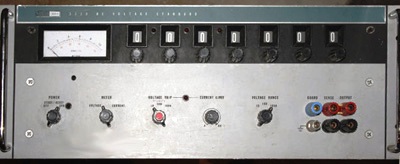
|
|
The Fluke 335D DC Voltage Standard/Null Detector provide the functions of a precision dc voltage standard with those of a differential voltmeter and high impedance null detector. In differential voltmeter mode, the "infinite" input resistance of true potentiometric measurement is obtained by adjusting the output of the calibrator to equal the unknown voltage, as indicated by zero deflection of the null detector. The null detector may also be used separately from the calibrator function when required by various in strumentation arrangements. Specifications As A Voltage Standard. Voltage Ranges: 10, 100, and 1000V with outputs as follows: 0 to 11.111110 (1 uV steps), 0 to 111.11110 (10 uV steps), 0 to 1111.1110 (100 uV steps). Output Current: 0 to 50 rnA. Accuracy of Output: ±(% of setting + uV). Stability of Output: ±(% of setting + uV). Overcurrent Protection: Automatic current limiting continuously adjustable from 1 to 60 rnA. Overvoltage Protection: Automatically disconnects load if output voltage exceeds 1 to 1200V setting of front panel controls. RIpple and Noise: 10V range, <=20 uV rms. 100V range,<= 30 uV rms. 1000V range, <= 40 uV rms, all frequencies. Setting Time: Typically within 10 ppm of final output in less than 20 seconds after a range change. Common Mode Noise Rejection: >=125 dB from dc to 400 Hz, up to 700V rms or 1000V dc. Isolation: Either output terminal may be floated up to 1000V dc from chassis ground. Remote Sensing: Separate terminals are provided to sense the output voltage directly at the load. As A Differential Voltmeter. Null Sensitivities: 1000V to 10 uV (full scale) in nine decade ranges. Any null sensitivity may be used on any voltage range. Input Resistance: Infinite at null from 0 to 1111.1110V dc. Meter and Dial Resolution: 0.1ppm of range.
|